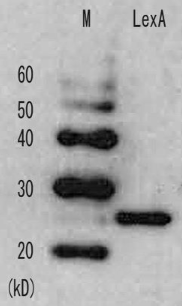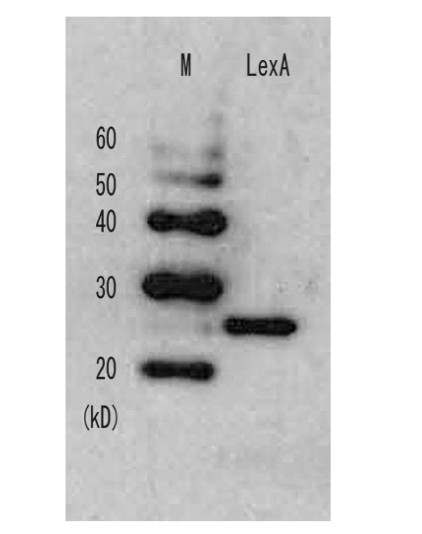1

Anti-LexA | LexA repressor
- Product Info
-
Immunogen: Full-size highly-purified recombinant LexA protein, UniProt: P0A7C2 Host: Rabbit Clonality: Polyclonal Purity: Serum. Contains 0.05% sodium azide. Format: Liquid Quantity: 50 µl Storage: Store at -20°C; once reconstituted make aliquots to avoid repeated freeze-thaw cycles. Please remember to spin the tubes briefly prior to opening them to avoid any losses that might occur from material adhering to the cap or sides of the tube. Tested applications: Chromatin immunoprecipitation (ChIP), Immunolocalisation (IL), Western blot (WB) Recommended dilution: 1: 1000 - 1: 3000 (WB) Expected | apparent MW: 22.3 | 23 kDa - Reactivity
-
Confirmed reactivity: Escherichia coli - Application Examples
-

Escherichia coli cells (1 × 10 8 cells/mL) were lysed in lysis buffer containing 20 mM Tris-HCl (pH 7.5), 150 mM NaCl, 1 mM EDTA, 1% SDS, and bacterial protease inhibitor cocktail (Sigma) and boiled followed by gel electrophoresis on 15% SDS-PAGE gels. Anti-LexA antibodies were used at 1: 1000.
For Western blot anti-LexA antibody can be combined with LexA protein as a positive control. - Additional Information
-
Additional information: This product can be used in:
- Studies of SOS regulation in E.coli
- Detection of bait constructs in yeast two-hybrid system
- Immunolocalization of LexA fusion proteins (fixed with 4 % formaldehyde)
- Immunoprecipiation and ChIP
- Background
-
Background: LexA represor binds specifically to the SOS-box sequence and represses the genes belonging to the SOS regulation. In response to DNA damage, RecA protein is activated by ss-DNA accumulated in the damaged cells and promotes autocleavage of LexA repressor by its coprotease activity. As a result, DNA repair genes and error prone polymerases are induced, and DNA damage is repaired and mutation is induced (1). The lexA gene is used for yeast two-hybrid experiments as a bait to identify the protein-protein interaction in vivo. Alternative names: exrA, spr, tsl, umuA
- Product Citations
-
Selected references: Hishida et al (2004) Role of the Escherichia coli RecQ DNA helicase in SOS signaling and genome stabilization at stalled replication forks. Genes Dev. 2004 Aug 1;18(15):1886-97. doi: 10.1101/gad.1223804. PMID: 15289460; PMCID: PMC517408. - Protocols
-
Agrisera Western Blot protocol and video tutorials
- Reviews:
-
This product doesn't have any reviews.


